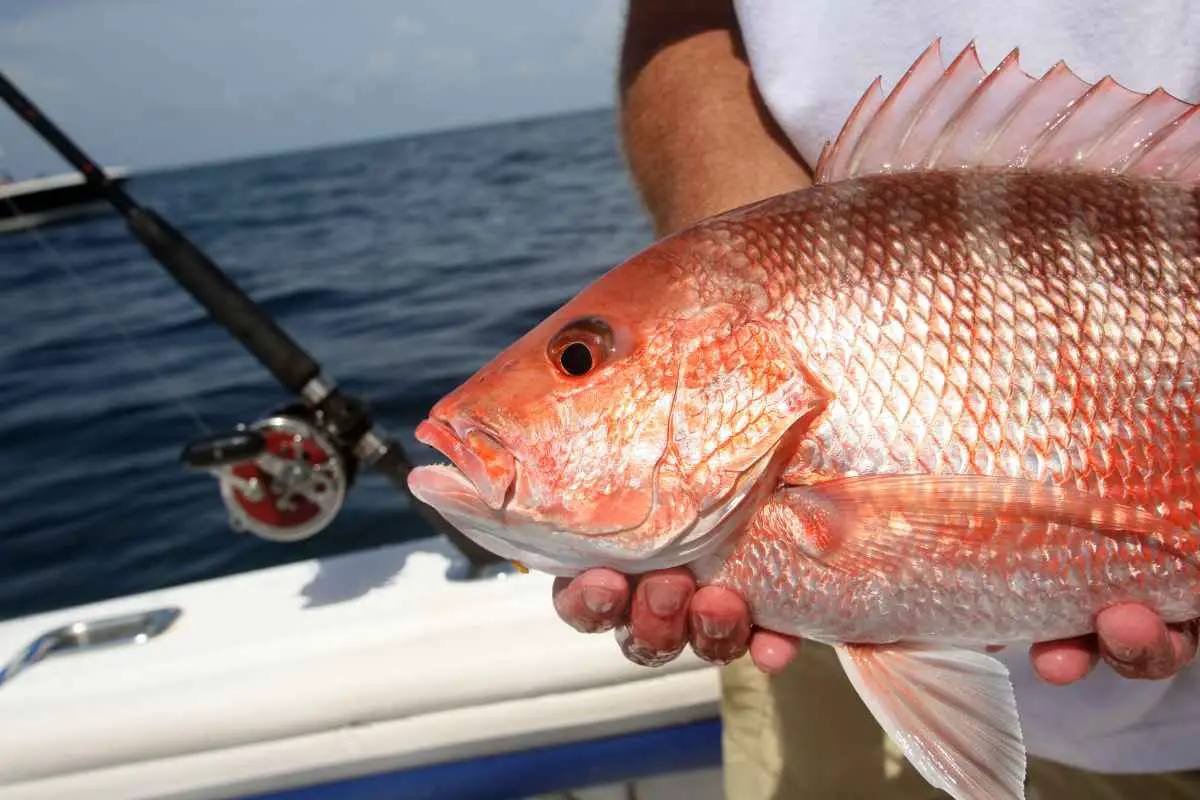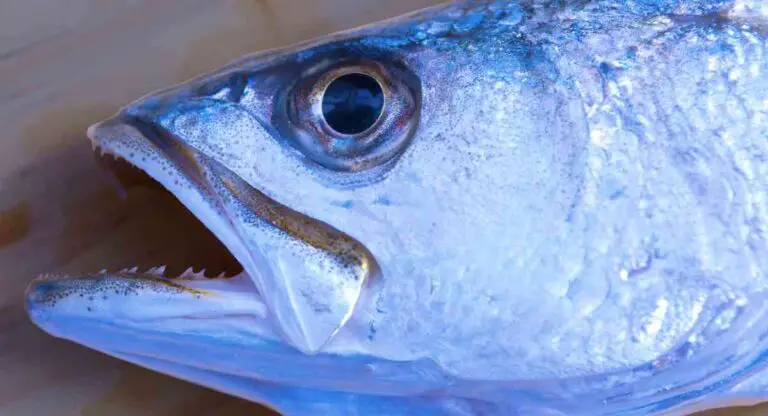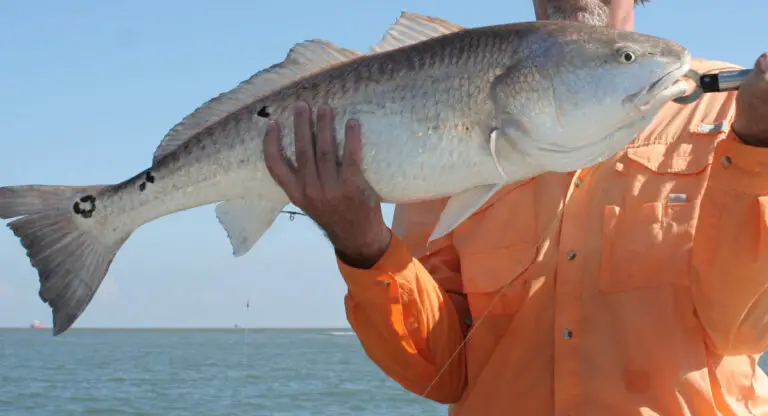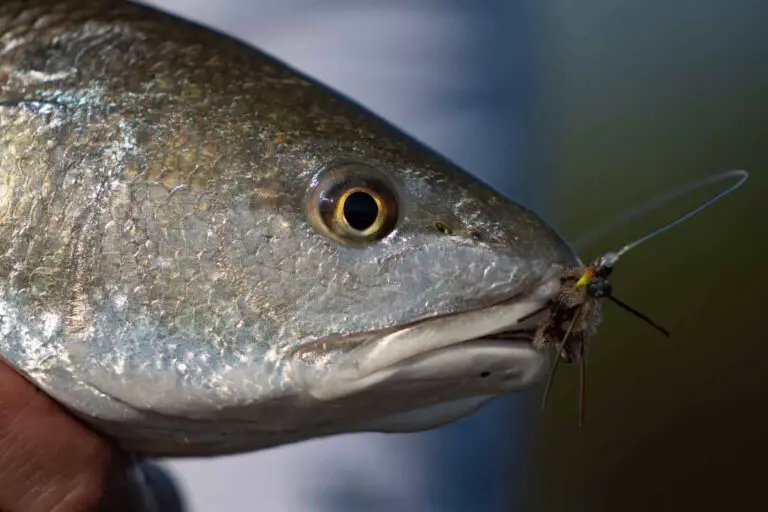Alabama Saltwater Fishing Regulations [2023]: Top 33 Game Fish
Ready to cast your line in Alabama’s saltwater? That’s where our Alabama Saltwater Fishing Regulations Guide comes in! It covers everything you need to know about fishing seasons, size limits, possession limits for various game fish, and the required Alabama Saltwater Fishing License. So, grab your gear and get ready to fish responsibly!
Here’s a sneak peek at some of the size and possession limits for Alabama’s top game fish:
- Red Drum (Bull Red): 16″ – 26″ Slot Size, Possession Limit: 3 fish per person per day
- Spotted Seatrout: 15″ – 22″ Slot Size, Possession Limit: 6 fish per person per day
- Sheepshead: 12″ Min, Possession Limit: 10 fish per person per day
- Flounder: 14″ Min, Possession Limit: 5 fish per person per day
- Cobia: 36″ Min, Possession Limit: 1 fish per person per day
- King Mackerel: 24″ Min, Possession Limit: 3 fish per person per day
- Gray Triggerfish: 15″ Min, Possession Limit: 1 fish per person per day applied to aggregate creel
Alabama Saltwater Fish Limit Definitions
Saltwater fishing size limits are designed to maintain optimum yields for recreational anglers statewide. In Alabama saltwater fishing, bag limits are established and bagged by species and, in some cases, size restrictions.
Each is regulated and enforced by the Alabama Department of Conservation and Natural Resources. Anglers are subject to fines for fishing and conservation violations.
- Bag limit – The maximum number of fish a person may catch in one day or per period. It’s usually limited to per person, per day, and on rare occasions, it includes a daily vessel limit.
- Creel limit – There is no difference between the bag and creel limits for Alabama fishing.
- Minimum size limit – The saltwater fishing regulations state that the fish must be larger than a certain size to be taken. These rules allow fish to reach a size where they can reproduce before being harvested.
- Slot limit – Slot limits are similar to the minimum size restriction in that there is both a maximum and minimum size limit and only fish that fit within the slot may be taken. This classification helps developing young fish mature while also shielding larger spawning fish.
- Season – Times of year open or closed to saltwater fishing for a certain species. A closed season protects fish from harvest during sensitive times of the year, such as spawning periods or heavy fishing.
Alabama Saltwater Fish Limits: Handy Quick Chart
It is essential for anglers to be aware of the size limitations for saltwater fish in Alabama to avoid hefty fines and suspension of their fishing privileges. A brief chart outlining the size limits for various popular saltwater fish species in Alabama is provided below:
| Species Name | Minimum Size Limit | Bag & Possession Limit | Season |
|---|---|---|---|
| Amberjack, Greater | 34 inch FL | 1 fish per person | Alabama state waters open and close along with federal regulations. |
| Amberjack, Lesser | 14 – 22 FL Slot Size | 20 fish per person applied to 20 fish aggregate creel limit for reef fish species with no other creel limit | Open year-round in state waters |
| Banded Rudderfish | 14 – 22 inch FL | 20 fish per person applied to 20 fish aggregate creel limit for reef fish species with no other creel limit | Open year-round in state waters |
| Cobia (Ling or Lemonfish) | 36 inch FL | 1 fish per person Limit 2 per vessel | Open year-round in state waters |
| Drum, Red | 16 – 26 inch TL Slot Size | 3 fish per person 1 oversized fish allowed | Open year-round in state waters |
| Flounder | 14 inch TL | 5 fish per person | Open: Jan 1 – Oct 31 Closed: Nov 1 – Nov 30 Open: Dec 1 – Dec 31 |
| Grouper, Black | 24 inch TL | 4 fish per person applied to 4 fish mixed species grouper aggregate creel limit | Alabama state waters open and close along with federal regulations. |
| Grouper, Gag | 24 inch TL | 2 fish per person applied to 4 fish mixed species grouper aggregate creel limit | Alabama state waters open and close along with federal regulations. |
| Grouper, Red | 20 inch TL | 2 fish per person applied to 4 fish mixed species grouper aggregate creel limit | Alabama state waters open and close along with federal regulations. |
| Grouper, Scamp | 16 inch TL | 4 fish per person applied to 4 fish mixed species grouper aggregate creel limit | Alabama state waters open and close along with federal regulations. |
| Grouper, Yellowfin | 20 inch TL | 4 fish per person applied to 4 fish mixed species grouper aggregate creel limit | Alabama state waters open and close along with federal regulations. |
| Mackerel, King | 24 inch FL | 3 fish per person | Open year-round in state waters |
| Mackerel, Spanish | None | 15 fish per person | Open year-round in state waters |
| Mullet | None | None | Open: Jan 1 – Oct 23 Oct. 24 – Dec. 31, 25 mullet per person from the shoreline or 25 perboat. No mullet by cast net or snagging in Theodore Industrial Canal, Dog River, Fowl River, and their tributaries. |
| Shark, All Other Species | 54 inch FL | 1 fish per person | Open year-round in state waters |
| Shark, Great Hammerhead | 78 inch FL | 1 fish per person | Open year-round in state waters |
| Shark, Scalloped | 78 inch FL | 1 fish per person | Open year-round in state waters |
| Shark, Sharpnose, Bonnethead | None | 1 fish per person | Open year-round in state waters |
| Shark, Shortfin Mako | Males: 71 inch FL Females: 83 inch FL | 1 fish per person | Open year-round in state waters |
| Shark, Smooth | 78 inch FL | 1 fish per person | Open year-round in state waters |
| Sheepshead | 12 inch FL | 10 fish per person | Open year-round in state waters |
| Snapper, Gray (Mangrove, Black) | 12 inch FL | 10 fish per person | Alabama state waters open and close along with federal regulations. |
| Snapper, Lane | 8 inch FL | 20 fish per person applied to 20 fish aggregate creel limit for reef fish species with no other creel limit | Alabama state waters open and close along with federal regulations. |
| Snapper, Red | 16 inch TL | 2 fish per person | Alabama state waters open and close along with federal regulations. |
| Snapper, Vermilion (Beeliner) | 10 inch FL | 10 fish per person | Alabama state waters open and close along with federal regulations. |
| Speckled Trout (Spotted Seatrout) | 15 – 22 TL Slot Size | 6 fish per person 1 oversized fish allowed | Open year-round in state waters |
| Striped Bass | 16 inch TL | 2 fish per person; Only 2 fish are allowed within MRD jurisdiction | Open year-round in state waters |
| Tarpon | 60 inch TL | $61 tag required | Open year-round in state waters |
| Triggerfish, Gray | 15 inch TL | 1 fish per person; applied to 20 fish aggregate creel limit for reef fish species with no other creel limit | Alabama state waters open and close along with federal regulations. |
| Tripletail (Blackfish) | 18 inch TL | 3 fish per person | Open year-round in state waters |
| Tuna, Bigeye | 27 inch CFL | No creel limit | Open year-round in state waters |
| Tuna, Yellowfin | 27 inch CFL | 3 fish per person | Open year-round in state waters |
All Prohibited Fish Species
We have the list of prohibited species conveniently listed here for you. Possessing fish caught of these species is illegal, and harvesting these species is strictly prohibited. There are associated fines for violations.
- Atlantic angel shark, Atlantic Manta, Basking shark, Bigeye sand tiger shark, Bigeye sixgill shark, Bigeye thresher shark, Bignose shark, Caribbean reef shark, Caribbean sharpnose shark, Dusky shark, Galapagos shark, Goliath grouper, Largetooth sawfish, Longbill spearfish, Longfin mako shark, Narrowtooth shark, Nassau grouper, Night shark, Red snapper (when in federal waters outside of Alabama’s territorial waters), Sand tiger shark, Sevengill shark, Sharks that are prohibited by the National Marine Fisheries Service, Silky shark, Sixgill shark, Smalltail shark, Smalltooth sawfish, Speckled hind, Spotted eagle ray, Warsaw grouper, Whale shark
- Daily Bag: 0, catch and release only; harvest prohibited.
Alabama Saltwater Fishing Size Limits
Alabama has set size limits for various saltwater fish species to protect and maintain healthy fish populations. Additionally, these size limits are in place to ensure that fish are given enough time to reproduce and grow to their full potential. As a result, following these size limits can help maintain a sustainable fishery in Alabama’s coastal waters.
Possession Limits for Saltwater Fish
Knowing the size and possession limits for the fish you catch when fishing in Alabama’s saltwater areas is crucial. Possession limits dictate the maximum number of fish of a particular species that you can possess at any given time.
In addition to possession limits, there is also a bag limit for each saltwater fish species. A bag limit refers to the number of fish an individual can catch and keep daily per person. For instance, anglers fishing in saltwater can catch and keep only two striped bass within the authority and control of the Alabama Marine Resources Division (MRD) over the state’s marine fisheries resources. One gray triggerfish per person is applied to a 20-fish aggregate creel limit.
Seasons and Regulations
In addition to specific seasons and regulations for saltwater fishing in Alabama, these regulations also dictate the possession limits for certain species. Therefore, checking the current regulations before heading out to fish is crucial. The most up-to-date regulations can be found on the Outdoor Alabama website.
It’s important to note that if you catch more fish than the possession limit for a specific species, you must immediately release the excess fish into the water. To avoid penalties, it’s essential to know the possession limits for the specific species you’re targeting, as these limits can vary based on various factors such as location, time of year, and the fish population’s health.
Gulf Reef Fish Species and Daily Creel Limits
Gulf reef fish species are important for recreational fishing in Florida, and their catch is regulated through daily creel limits. The daily creel limit for Gulf reef fish species is determined by the type of fish and the fishing location.
The Alabama Department of Conservation and Natural Resources and the National Oceanic and Atmospheric Administration (NOAA) regulate daily creel limits for these species, and fishermen must abide by these regulations. The MRD has established a TL daily creel limit for Gulf reef fish species based on total length, while the NOAA has established an FL daily creel limit based on fork length.
It’s a fisherman’s responsibility to measure their catch according to the appropriate method and ensure they do not exceed the daily creel limit for the species they catch. Failure to comply with these regulations can result in penalties and fines.
Who Enforces Alabama Saltwater Fish Limits?
Violating these regulations can result in fines and other penalties, which is why following them is important.
The Alabama Marine Resources Division is the agency responsible for enforcing these regulations. They can issue citations and fines to individuals who break the rules. It is crucial to understand and follow the size and possession limits for each species of saltwater fish in Alabama to avoid penalties.
Penalties for Violating Saltwater Fish Limits
If you violate saltwater fish limits in Alabama, you may be subject to fines and other penalties. The exact penalties depend on the severity of the violation and the number of fish involved. In some cases, individuals may also have their fishing license suspended or revoked.
Red Drum is one of Alabama’s most popular saltwater fish, with a size limit of 16 to 26 inches. This means that any Red Drum caught that is below 16 inches or over 26 inches must be released back into the water. Releasing undersized or oversized fish ensures that Red Drum populations will continue to thrive.
How To Measure Your Catch
Measure Fish According to Alabama Regulations
You’ll need a ruler or measuring tape marked in inches to measure a fish’s fork length. Place the end of the ruler or tape at the tip of the fish’s mouth and measure straight back to the fork in the tail. This measurement should be rounded down to the nearest inch. To measure a fish’s total length, follow the same process, but measure to the end of the tail.
Measuring your fish accurately is important to ensure they meet the size limits of Alabama regulations. If a fish is undersized, it must be released immediately to avoid penalties and fines. Always consult the latest regulations before heading out on your fishing trip to ensure you comply with the law.

Fork Length vs. Total Length
Regarding measuring fish according to Alabama regulations, there are two types of measurements you need to know: fork length and total length. Fork length is measured from the tip of the fish’s mouth to the fork in the tail, while total length is measured from the tip of the fish’s nose to the end of its tail.
It’s important to understand the difference between these two measurements, as the size limit for a particular fish species may be based on either fork length or total length. To avoid any violations and fines, it’s crucial to check the regulations for the specific species you plan to catch and make sure you measure your catch correctly.
Federal Regulations
Knowing the federal recreational and commercial fishing regulations is important if you plan to fish in Alabama’s saltwater areas. The Gulf of Mexico Fishery Management Council regulates federal waters extending 3 to 200 miles offshore. These regulations are designed to protect fish populations and ensure sustainable fishing practices.
Recreational Offshore Landing Permit
If you intend to fish for specific species in federal waters, you may have to acquire a Recreational Offshore Landing Permit (ROLP). Anglers who intend to catch or possess certain species, such as red snapper, grouper, and amberjack, must have this permit. You can obtain the permit for free online or at designated locations.
Once you have your ROLP, you will receive a unique identification number that you must include in your fishing trip report. Regardless of whether you caught any fish or not, you must submit the report within 24 hours of returning to shore. This report aids fishery managers in monitoring catch and effort data, which is critical for making informed decisions about fishing regulations.
It’s essential to keep in mind that the ROLP is only mandatory for certain species in federal waters. There is no need to obtain a permit if you are fishing in state waters. Nevertheless, you should still be aware of all species’ size and creel limits since they may differ from federal regulations.
Alabama Fishing License Options for Saltwater
If you plan on fishing in saltwater areas of Alabama, you will need a Saltwater Fishing License. Luckily, Alabama offers saltwater license options for both residents and non-residents. Here are the different license options available:
Saltwater Package License Prices
The Saltwater Package License is the most popular option for anglers frequently fishing in saltwater areas. This license includes a saltwater fishing license and a saltwater reef fish endorsement. Here are the prices:
| Category | Type of License | Expiration | Resident Cost | Non-Resident Cost |
|---|---|---|---|---|
| Sport Fishing License | Saltwater Annual Fishing | Expires August 31 | $26.50 | $26.50 |
| Sport Fishing License | Saltwater 7-Day Fishing | Valid for 168 consecutive hours | $11.00 | $11.00 |
| Sport Fishing License | Saltwater Reef Fish Endorsement | Expires August 31 | $10.00 | $10.00 |
| Sport Fishing License | Saltwater Pier | Expires August 31 | $6.85 | $12.10 |
| Sport Fishing License | Saltwater 64 Lifetime | Lifetime | $26.50 | |
| Spearfishing License | Annual | Expires August 31 | $6.00 | $8.50 |
| Spearfishing License | 7-Day Trip | Valid for 168 consecutive hours | $3.50 | $3.50 |
Age requirements to fish for free:
- Residents of Alabama who are 65 years or older are eligible for a free freshwater or saltwater fishing license.
- Children under 16 years old are exempt from the freshwater fishing license requirement. However, if they plan to fish for saltwater species, they must have a valid saltwater fishing license or be accompanied by an adult who has one.
- Active-duty military personnel and their immediate family members stationed in Alabama are eligible for a free saltwater or freshwater fishing license.
Check out our latest blog post for a comprehensive guide on buying your Alabama fishing license, covering all types of fishing, resident status, and various options available.
Frequently Asked Questions
If you plan to go saltwater fishing in Alabama, you may have questions about the regulations and size limits. Here are some frequently asked questions to help you out:
In Alabama, having a saltwater fishing license is mandatory for anyone who wants to fish or possess fish in saltwater areas. However, there are a few exceptions to this rule. Firstly, residents and non-residents under 16 are exempt from this requirement. Additionally, residents who are 65 years or older are also exempt from having a saltwater fishing license. Moreover, residents can fish from a licensed public fishing pier in the inside waters without purchasing a fishing license.
The rules for how big and how many saltwater fish you can catch in Alabama differ for each type of fish. You should always check the regulations for the specific fish you want to catch to avoid penalties. You can find these in our handy chart in this article or in the rules on Outdoor Alabama’s website, or ask for more information at the Gulf Shores or Dauphin Island office.
No, it is illegal to possess undersized fish. If you catch a fish smaller than the minimum size limit, you must immediately release it back into the water. Keeping undersized fish can result in fines and penalties.
If you catch a fish not mentioned in the regulations, you should release it back into the water. It is illegal to possess fish that are not in the regulations.
Yes, you can fish in federal waters if you have the appropriate license and follow the regulations set by the Gulf of Mexico Fishery Management Council. The regulations for federal waters may differ from the state regulations, so it’s important to check both before fishing.
Conclusion
The Alabama Saltwater Fishing Regulations Guide provides information on fishing seasons, size limits, possession limits for various game fish, and the required Alabama Saltwater Fishing License. Alabama has specific seasons and regulations for saltwater fishing, and anglers should be aware of size limitations and possession limits for saltwater fish to avoid penalties.
This guide outlines the size limits for various popular saltwater fish species in Alabama. The Alabama Marine Resources Division enforces the regulations, and violations may result in penalties or fines.
- Alabama has set size limits for various saltwater fish species to protect and maintain healthy fish populations.
- Possession limits are the maximum number of fish of a particular species that you can possess at any given time.
- Alabama has specific seasons and regulations for saltwater fishing, and anglers should be aware of size limitations and possession limits for saltwater fish to avoid penalties.
- The Alabama Marine Resources Division enforces the regulations, and violations may result in penalties or fines.







